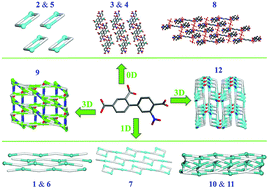A new series of Co, Ni, Zn, and Cd metal–organic architectures driven by an unsymmetrical biphenyl-tricarboxylic acid: hydrothermal assembly, structural features and properties†
Abstract
This study reports the hydrothermal synthesis of a novel series of twelve coordination compounds, namely, {[Cd(μ-Hnbtc)(H2O)4]·H2O}n (1), [Zn2(μ-Hnbtc)2(phen)2]·2H2O (2), [Zn(Hnbtc)(phen)2(H2O)]·4.5H2O (3), [Ni(Hnbtc)(phen)2(H2O)]·6H2O (4), [Zn2(μ-Hnbtc)2(2,2′-bipy)2]·2H2O (5), [Cd3(μ5-nbtc)(μ6-nbtc)(2,2′-bipy)2(H2O)]n (6), {[Zn3(μ3-nbtc)2(phen)3(H2O)2]·4H2O} (7), [Co(H2O)6][Co2(nbtc)2(μ-4,4′-bipy)(4,4′-bipy)2(H2O)6]·8H2O (8), {[Ni3(μ4-nbtc)2(μ-4,4′-bipy)2.5(μ-H2O)(H2O)3]·4H2O}n (9), {[Cd2(μ4-nbtc)(μ-OH)(2,2′-bipy)2]·H2O}n (10), [Cd2(μ4-nbtc)(μ-OH)(phen)2(H2O)]n (11), and {[Zn2(μ5-nbtc)(μ3-OH)(μ-4,4′-bipy)]·4,4′-bipy·H2O}n (12), which are derived from 3′-nitro-biphenyl-2,4,4′-tricarboxylic acid (H3nbtc) as a virtually unexplored building block. These compounds were generated in aqueous medium from the corresponding metal(II) chlorides as a metal source, H3nbtc as a principal building block, NaOH as a base, and simple N,N-donor aromatic ligands as crystallization mediators (i.e., 1,10-phenanthroline, phen; 2,2′-bipyridine, 2,2′-bipy; or 4,4′-bipyridine, 4,4′-bipy). All products 1–12 were completely characterized in the solid state by IR spectroscopy, elemental and thermogravimetric (TGA) analyses, powder (PXRD) and single-crystal X-ray diffraction. Structures of 1–12 range from discrete 0D dimers (2 and 5) or monomers (3, 4, and 8) to 1D coordination polymers (CPs, 1, 6, 7, 10, and 11) and 3D metal–organic frameworks (MOFs, 9 and 12). A broad structural diversity of 1–12 is guided by the type of the metal(II) node, the molar ratio between H3nbtc and sodium hydroxide, and the kind of crystallization mediator. Topological analysis and classification of metal–organic underlying nets was made, disclosing the following topological types: 2C1 (in 1 and 7), 1M2-1 (in 2 and 5), SP1-periodic net (in 10 and 11), tfz-d (in 12), and some topologically unique nets (in 6 and 9). Luminescence behavior of 1–3, 5–7, and 10–12 was studied in the solid state. Magnetic properties of a Ni(II) MOF 9 were also investigated and modeled. All obtained products 1–12 represent the first structurally characterized examples of coordination compounds derived from H3nbtc, thus opening up its application in coordination chemistry as a novel tricarboxylate building block.



 Please wait while we load your content...
Please wait while we load your content...